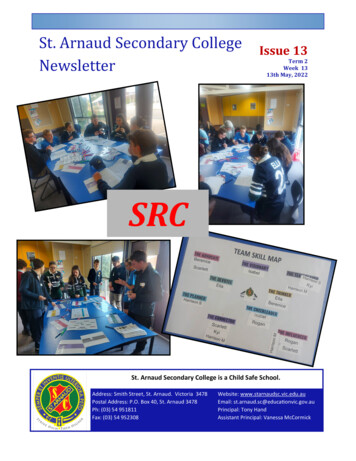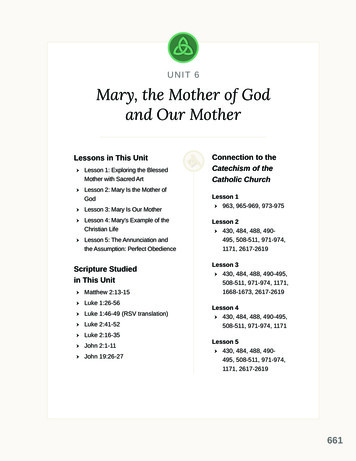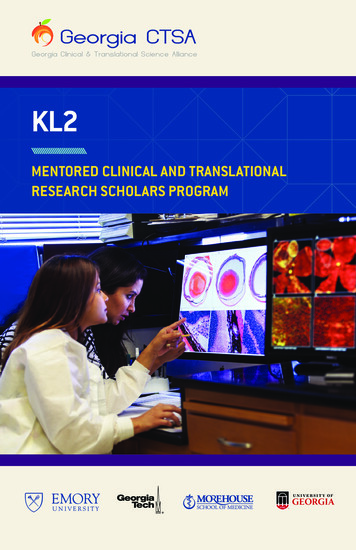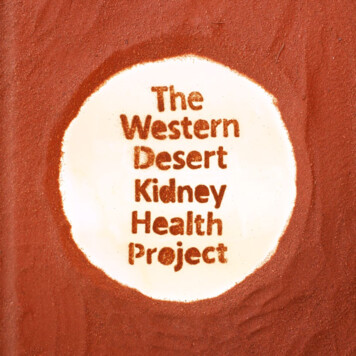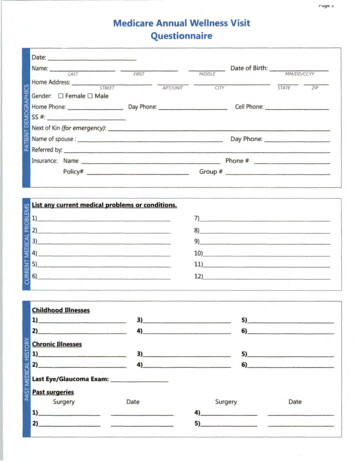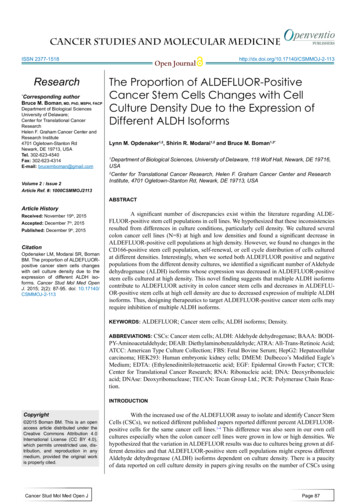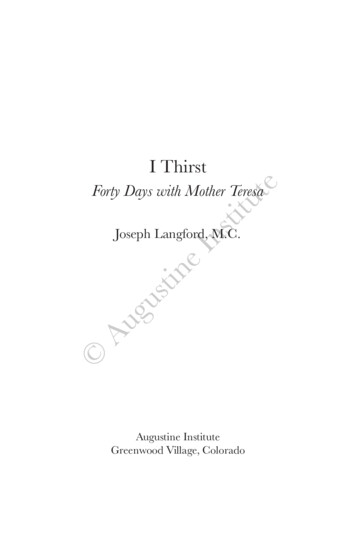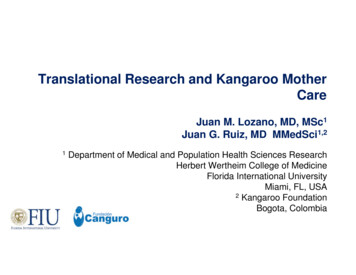
Transcription
Translational Research and Kangaroo MotherCareJuan M. Lozano, MD, MSc1Juan G. Ruiz, MD MMedSci1,21Department of Medical and Population Health Sciences ResearchHerbert Wertheim College of MedicineFlorida International UniversityMiami, FL, USA2 Kangaroo FoundationBogota, Colombia
Outline Neonatal mortality:o Current facts and reduction goals.o Available interventions.o Gaps. Translational scienceo Definitions.o Components. KMC and translational scienceo Achievements.o Pending tasks and challenges.
Neonatal Mortality: Reduction GoalsEhret DY, et al. Clin Perinatol. 2017;44:567-82
Neonatal Mortality: Main Current FactsIndicatorNeonatal deaths / yearMain causesPre-term birthIntrapartum complicationsSepsisRelative risk of death**Pre-term birthIntrapartum complicationsSepsisWorldLMIC*2.7 million2.4 million (90%)35%24%15%40%22%15%----103634* LMIC: Low / middle income countries with neonatal mortality rate 30 per 1,000 LB** Risk of death settings NMR 30 compared with NMR 5
Effective,simple, lowcostinterventionsto address 3main causesare availableEhret DY, et al. ClinPerinatol. 2017;44:567-82KangarooMother Care
Estimated effect of interventions on preterm-related directcomplicationsBhutta ZA, et al. Lancet 2014;384:347–70.
OutcomeMortalityNeonatal sepsisHypothermiaHypoglycemiaHospital readmissionExclusive breastfeeding increase* Relative risk reductionRRR* (%)36477888585095% CI11 - 6417 - 6659 - 8868 - 9524 - 7726 - 78Boundy EO, et al. Kangaroo Mother Care and Neonatal Outcomes: AMeta-analysis. Pediatrics. 2015;137:e20152238
Why Neonatal Mortality Remains High?1. Coverage Gap: Many do not receive basic andpotentially lifesaving treatments (insufficient coverage).2. Quality Gap: Services are available but care is ofinadequate quality or is ineffective.3. Data Gap: Unknown baseline coverage rates for someinterventions.
Coverage Gap25% Coverage PretermHospital careKMC not routinelyincludedBhutta ZA, et al. Lancet. 2014;384:347–70.
Quality and Data GapsEhret DY, et al. Clin Perinatol. 2017;44:567-82
TRANSLATIONAL “SCIENCE”CURRENT CONCEPTS
Translational Research (Acad Med 2010;85:470-5) NIH and IOM: Two areas of translation:o Applying discoveries generated in laboratory and preclinicalstudies to studies in humans.o Enhancing the adoption of best practices in the community. National Cancer Institute: Transforms scientificdiscoveries from laboratory, clinical, or population studiesinto clinical applications.Rubio et al: Multidirectional integration of research(basic, patient-oriented, population-based) to improve thehealth of the public (Acad Med, 2010).
Glasgow RE, et al. Am J Public Health. 2012;102:1274-81
The knowledge integration process
KMC and TR: T1 - T2 (studies, systematicreviews, guidelines) Individual studies: Synthesis / systematic reviews: More than 2,000 published papers on studies.More than 120 reporting on efficacy-effectiveness and safety.At least 5 good quality systematic reviews.Sound evidence of efficacy.Clinically significant risk reduction / improvement of outcomes.Synopsis: Several EB guidelines (Fundacion Canguro, WHO, etc.).
The Knowledge integration process
KMC and TR: T3 (systems & QI programs) Country level (Colombianexample) Ministry of Health and FundacionCanguro Written Health System PolicyNormsImplementation protocolsQuality assurance protocolsTraining Internet-based tools
The Knowledge integration process
KMC and TR: T4 (dissemination andimplementation) Diffusion Efforts at Global Level Fundacion Canguro Implementation Model See one, Do one, Teach oneInternational teams trained for Africa, South East Asia,India, Latin America, Eastern EuropeOthers: Save the Children, USAID, WHO / Unicef ENAPinitiative
So, we seem to be complying
However: KMC - Slow Diffusion and Uptake
Barriers to evidence uptakeLang ES, et al. Ann Emerg Med. 2007;49:355-63
Diffusion vs. Implementation Besides knowledge transfer and diffusion, implementation isneeded to achieve true knowledge translation.Researchers must play an active role (publication ofevidence is not enough).Implementation models need to be chosen and scaled up(one size does not fit all).Choice of models should be guided by empirical evidence ontheir effectiveness (translational research).
Scaling-up Challenges in LMIC Be able to: Simplify, standardize and adapt the intervention while . maintaining essential components required for effectiveness.Avoid trivialization.Customize maintaining minimal acceptable standards.Develop efficient, COI free implementation process: Avoiding / preventing waste of resources.Preventing / containing corruption.Maintaining transparency and accountability.
Scaling-up Challenges in LMIC Achieving Targets: UptakeSustainabilityQuality assurance / improvementStrategies and procedures for implementation in specialcases: “Difficult” settingsZones of conflict
Conclusions Burden due to prematurity and LBW remains high.Simple, low-cost efficacious strategies can impact thisproblem.Basic neonatal hospital care (including KMC) could reduceLBW related mortality by half.Uptake is suboptimal and slow.Major gaps in implementation persist: CoverageQuality of interventionsInformation
Recommendations Current dissemination of knowledge must be energized: largescale implementation Identifying champions at world level.Need for global implementation plans.Engaging actors and communities.Evaluate and incorporate novel forms of financial sustainablesupport.
Recommendations Dissemination and implementation MUST address quality andcontinuous quality improvement.Long term transformation of education of health careproviders should be included Evidence – based practiceQuality Improvement culture
Translational Research and Kangaroo Mother CareJuan M. Lozano - jlozanol@fiu.eduJuan G. Ruiz – jruizpel@fiu.edu
Translational Research (Acad Med 2010;85:470-5) NIH and IOM: Two areas of translation: o Applying discoveries generated in laboratory and preclinical studies to studies in humans. o Enhancing the adoption of best practices in the community. National Cancer Institute: Transforms scientific discoveries from laboratory, clinical, or population studies into clinical applications.
